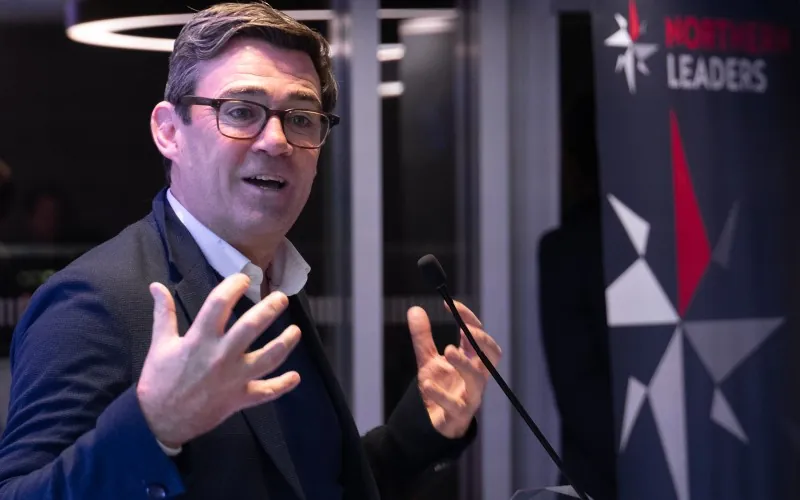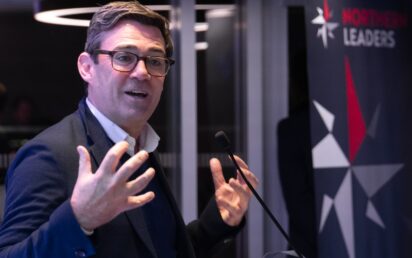Greater Manchester Mayor Andy Burnham has unveiled the region’s vision for the next decade, with sights firmly set on becoming a second city to rival any other on the planet by 2050.
The city region is eyeing a new era of economic growth, with new underground transport services and a flagship underground station at Manchester Piccadilly.
Speaking to a packed room at Manchester’s Campfield on Wednesday, Burnham shared the city region’s blueprint for a greener, fairer future.
The announcements were made during the launch of The Greater Manchester Strategy 2025-2035.
At its heart is a Growth Plan and a People Plan, which are aiming to ensure that every person and every place in Greater Manchester feels the benefits of economic growth.
Burnham pledged that, by 2027, Greater Manchester will be building more social housing than it is losing through right-to-buy.
The Mayor also revealed plans for new bus routes, tramlines and train stations to connect communities across the city region with an integrated, lower cost transport system.

Construction of a tram stop to service new homes at Victoria North will start by 2028, while work to bring Metrolink to Stockport will begin by 2030.
Two commuter rail lines will also join the Bee Network by next December, with another six joining by 2028.
To help connect young people with work and study opportunities, Greater Manchester will also introduce half price bus travel for 18-21-year-olds from September 2025. A pilot of free 24-hour bus travel for older and disabled people will also be rolled out in August.
Burnham announced Sebastian Coe as chair designate of a new Mayoral Development Corporation (MDC) to spearhead the Old Trafford regeneration scheme – the biggest sports-led scheme since the London 2012 Olympic and Paralympic Games, which Lord Coe played a significant role in.
Steve Coogan was named co-chair designate of the proposed Middleton MDC alongside Rose Marley, chief executive of Co-operatives UK.
The Mayor also announced plans to unlock transformative investment in transport infrastructure, so that by 2050 Manchester Piccadilly has an underground tram and train station with a high-speed rail link to Liverpool and regeneration of the surrounding area, making it ‘the Kings Cross of the North’.
“Our first decade of devolution has shown how much we can achieve by working together,” said Burnham. “We’re the UK’s fastest growing economy and stand on the cusp of what I believe could be our best decade since the Victorian era.”
“Our task for the next decade is to build a platform for success for all our residents. We’ve never believed in a ‘trickle-down’ model of growth here – that if a few people and places do well then, somehow, that will benefit everyone.
“We know we will only change the fortunes of all our people and places if we’re prepared to intervene and fix the foundations of life.
“That means making sure everyone has a healthy home, in a safe and welcoming community; it means offering people support to tackle the everyday stresses and strains of life; and it means helping all our young people to fulfil their potential by providing a clear line of sight to great jobs in our growing economy, with strong technical routes as well as academic ones.
“All this must be underpinned by a low-fare public transport system, connecting people to opportunities.
“We’ve proved that we’re ready to forge our own place-based solutions and the Government has recognised this by making us the UK’s first ‘Prevention Demonstrator’.
“We’ll develop a better way of delivering public services, treating people as names not numbers and creating the conditions for everyone to live well, rather than waiting until people are in crisis to offer support.
“Our vision is ambitious, but in my eight years as Mayor, I’ve learned that, when we pull together, there’s nothing we can’t achieve.
“There’s a long and proud tradition of collaboration in Greater Manchester. Devolution has turbocharged that and now we’re ready to deliver a new model of growth where no one is left behind.”
The new Mayoral Development Corporations (MDCs) and Zones (MDZs) are tools which will look to kickstart regeneration.
MDCs are statutory bodies, set up by the Mayor, designed to speed up development and attract investment within a specific area. They can take on broad powers including land acquisition, planning, and infrastructure functions.
MDZs draw together stakeholders to drive regeneration and unlock barriers to growth.
In addition to Old Trafford and Middleton, Bolton will also get an MDC to drive growth in its town centre, creating new jobs and homes.
A new MDC will accelerate work to create an advanced manufacturing and materials cluster at Atom Valley – a site which straddles Oldham, Rochdale and Bury.
An MDC covering Ashton and Stalybridge will aim to create a national template for transport-led regeneration, while a new MDZ for Leigh and the surrounding area will help bring forward a major new University Campus for health and social care.


